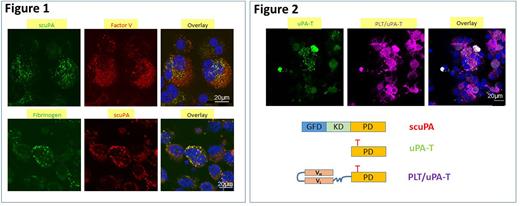Abstract
We wish to develop a clinically relevant strategy to deliver anti-thrombotic urokinase plasminogen activator (uPA)-carrying platelets (uPA-PLTs) as a targeted thromboprophylaxis that can be administered to patients with a concurrent high risk of bleeding. This intent was based on our previous data showing that transgenic mice, ectopically expressing uPA in megakaryocytes (MKs), released PLTs, containing uPA in α granules, that were effective as a thromboprophylaxis agent (PMID12689937). We faced two major challenges in further developing uPA-containing PLTs for clinical application: (1) How to get uPA into PLTs as human Plts do not take up uPA, and (2) α-granular uPA led to proteolysis of other α-granule proteins.
To diminish degradation of α-granular proteins by uPA, we generated a plasmin-insensitive, but thrombin-activatable, truncated uPA mutant (uPA-T, bottom, Fig. 2). We found that both native single-chain uPA (scuPA) and uPA-T can be taken up by human MKs into the same α granules whereby they co-localize with endocytosed Factor V (FV) and/or fibrinogen (FBGN), as evidenced by confocal microscopy, suggesting that the uPA variants use the same endocytic receptor pathway, also utilized by FV and FBGN (Fig. 1).
To delineate what receptor system(s) mediate uPA uptake by CD34+ MK, we found that FV (known to be partially internalized via low-density lipoprotein receptor-related protein 1 (LRP1) competed with both uPA variants for uptake, and that uptake of uPA variants and FV was partially inhibited by the LRP1 antagonist, receptor-associated protein (RAP), further supporting that LRP1 mediates internalization of the uPAs. We also found that uPA and FBGN uptake was partially inhibited by αIIbβ3 integrin antagonist ReoPro.
Since we observed that LRP1 protein expression and extent of uPA uptake by MKs declines upon maturation, whereas αIIbβ3 expression does not, we tested if targeting of uPA to αIIbβ3 would facilitate its uptake by CD34+ MKs. We generated a chimeric prodrug composed of a single-chain version of the variable region (scFv) of an anti-αIIbβ3 monoclonal antibody fused to uPA-T (PLT/uPA-T, bottom Fig. 2) which binds human αIIbβ3 on both quiescent and activated PLTs, and is enzymatically activated specifically by thrombin. We have previously shown that in two murine injury models, PLT/uPA-T did not lyse preexisting clots, while it concurrently prevented the development of nascent thrombi (PMC4731161). However, direct infusion of PLT/uPA-T in mice caused significant thrombocytopenia. Now, we found that CD34+ MK internalized PLT/uPA-T into the same α granules of MKs, but with significantly higher efficiency than uPA-T protein (top Fig. 2) which will optimize loading of MKs by uPA-T for subsequent use as a source of uPA-PLTs.
We found that scuPA-loaded platelets released from infused MKs prevent thrombus formation in a Rose Bengal photochemical injury model. These studies were done using immunocompromised NOD-scid IL2rγnull (NSG) mice homozygous for VWFR1326H (a VWF mutation switching binding specificity from mouse to human GPIb/IX). NSG/VWFR1326H mice had impaired clotting after vascular injury compared to NSG mice unless infused with human PLTs or MKs. We found that MKs that endocytosed uPA-T can also prevent thrombi formation in this model.
Future studies will test whether PLTs released from PLT/uPA-T-loaded MKs would further enhance efficacy of this thromboprophylactic strategy, while avoiding thrombocytopenia, and can become a point-of-care thromboprophylaxis therapeutic in the clinical setting of high-risk of developing thrombi with concurrent concerns of inducing significant bleeding.
Disclosures
No relevant conflicts of interest to declare.
Author notes
Asterisk with author names denotes non-ASH members.


This feature is available to Subscribers Only
Sign In or Create an Account Close Modal